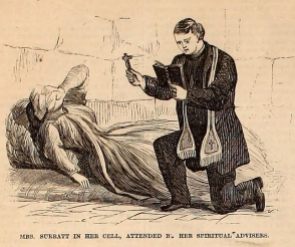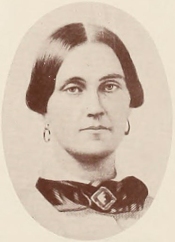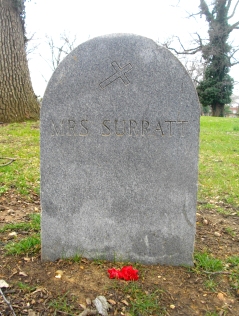14 thoughts on “Mary Surratt Pictures”
Leave a comment Cancel reply
This site uses Akismet to reduce spam. Learn how your comment data is processed.
Search this site by keyword:
Recent Comments
| Dave Taylor on 2024 Surratt Society Virtual C… | |
| Julia Grant on 2024 Surratt Society Virtual C… | |
| Dave Taylor on An Update Regarding John Wilke… | |
| Dave Taylor on 2024 Surratt Society Virtual C… | |
| Carlos Harley on More about Oswell Swann | |
| millerwms on On the Manhunt: The Search for… | |
| Ira Harris, US Senat… on 2024 Surratt Society Virtual C… | |
| Aaron on An Update Regarding John Wilke… | |
| damiansutton on On the Manhunt: The Search for… | |
| Dave on Manhunt Review: Episode 1 |
Dave’s Speaking Engagements in 2023-24
Want to come heckle LincolnConspirators.com author Dave Taylor in person? Here are some of my public speaking engagements planned for the future.
Date: TBD Saturday(s) in 2024
Location: Surratt House Museum (9118 Brandywine Road, Clinton, MD 20735)
Time: 7:00 am – 7:00 pm
Speech: John Wilkes Booth Escape Route Bus Tour
Description: Dave is one of the narrators for the Surratt Society’s John Wilkes Booth Escape Route Tour. The 12 hour bus tour documents the escape of the assassin through Washington, D.C., Maryland, and Virginia. Information on how to register can be found here: http://www.surrattmuseum.org/booth-escape-tour
Cost: $85
Additional speeches and information will be posted when available. Past speaking engagements can be seen here: https://lincolnconspirators.com/about/
If you are interested in having Dave speak to your group about any aspect of the Lincoln assassination story, click to Contact or send an email to admin@LincolnConspirators.com
Links to Learn More
Pages
- About
- Calendar
- Index
- John Wilkes Booth in the Woods
- Lincoln Assassination Maps
- On This Day
- Picture Galleries
- “Booth” Mummy Pictures
- Baptist Alley Pictures
- Booth Family Pictures
- Bowling Green Pictures
- Cleydael Pictures
- David Herold Pictures
- Dr. Mudd House Pictures
- Dr. Samuel Mudd Pictures
- Edman Spangler Pictures
- Fake Conspirators Pictures
- Found on Booth
- George Atzerodt Pictures
- Horsehead Tavern Pictures
- Huckleberry & Thomas Jones Pictures
- John Surratt Pictures
- John Wilkes Booth Photos
- Mary Surratt Pictures
- Michael O’Laughlen Pictures
- Mrs. Quesenberry’s Home Pictures
- Nanjemoy Creek Pictures
- On the Stage Pictures
- Pine Thicket Pictures
- Port Conway & Port Royal Pictures
- Port Tobacco Pictures
- Rich Hill Pictures
- Samuel Arnold Pictures
- Seward Assassination Attempt Pictures
- Sneaking Up Pictures
- Surratt House and Tavern Pictures
- The Derringer Pictures
- The Leap Pictures
- The Shot Pictures
- Remembering Art Loux
- The Trial
- Introduction
- May 1, 1865
- May 6, 1865
- May 8, 1865
- May 9, 1865
- May 10, 1865
- May 11, 1865
- May 12, 1865
- May 13, 1865
- May 15, 1865
- May 16, 1865
- May 17, 1865
- May 18, 1865
- May 19, 1865
- May 20, 1865
- May 22, 1865
- May 23, 1865
- May 24, 1865
- May 25, 1865
- May 26, 1865
- May 27, 1865
- May 29, 1865
- May 30, 1865
- May 31, 1865
- June 1, 1865
- June 2, 1865
- June 3, 1865
- June 5, 1865
- June 6, 1865
- June 7, 1865
- June 8, 1865
- June 9, 1865
- June 10, 1865
- June 12, 1865
- June 13, 1865
- June 14, 1865
- June 15, 1865
- June 16, 1865
- June 17, 1865
- June 19, 1865
- June 20, 1865
- June 21, 1865
- June 22, 1865
- June 23, 1865
- June 24, 1865
- June 26, 1865
- June 27, 1865
- June 28, 1865
- June 29, 1865
- June 30, 1865
- Witnesses by Date
- Mary Surratt Testimony
- Lewis Powell Testimony
- David Herold Testimony
- George Atzerodt Testimony
- Dr. Samuel Mudd Testimony
- Samuel Arnold Testimony
- Michael O’Laughlen Testimony
- Edman Spangler Testimony
- Videos
Archives
Stats
- 2,091,279 Views
Blog Stuff
Copyright
Questions, comments, corrections or suggestions can be sent to Dave Taylor, the creator and administrator of this site. All the text, except reprinted and excerpted articles, has been written by the webmaster, ©2012-2024. All rights reserved.













































Pingback: New Gallery – Mary Surratt | BoothieBarn
Pingback: Mary Surratt’s Photograph | BoothieBarn
Pingback: The Fake “Mrs Surat” | BoothieBarn
Just how innocent people would like to believe Marry Surratt is based on what? I believe she was guilty, not just guilty of conspiracy to kidnap as well as assassinate Lincoln, but do belive that she may have been the ringleader calling all the shots. Booth took orders from her.
I’m the director of the Surratt House Museum, and we take no stand as to Mrs. Surratt’s innocence or guilt. We present facts on both sides of the issue and hope that we intrigue our visitors enough to do more reading on the subject and form their own opinions — which you have done.
On a personal level, I have studied the Lincoln assassination story for over 60 years and have my own opinion of the lady. I think that she was a product of her time, well-educated for a woman, married to a man that never gave her the life she wanted for herself and her children, the daughter of a slaveholder, the wife of a slaveholder, and ultimately the owner of slaves upon her husband’s death in 1862 and until Maryland freed its slaves with a new state constitution in November of 1864 (the Emancipation Proclamation had no legal effect on slavery in that state).
Her husband was a well-known secessionist who maintained a Confederate safehouse on the courier route between Richmond and DC, and she continued to maintain it after his death and then entertained spies at her boardinghouse upon her move to the city in late-1864. Her son became one of those couriers, and her eldest son had left town on Inauguration Day in 1861 and headed south, where he later joined a Confederate cavalry unit operating out of Texas.
To me, all of those factors would certainly indicate that she would be ripe for cooperating in the original plot to kidnap the President, especially since her courier son was in on it until the aborted plan in March of 1865. That said, however, I would certainly not brand her as the ringleader giving orders to Booth. That young man was not inclined (especially after the fall of Richmond) to take orders from anyone – least of all a woman!
Her fatal mistake was continuing to associate with Booth (or to be manipulated by him) after her son left the plot and headed to Canada on another piece of espionage under the leadership of Gen. Edwin G. Lee. By likely having knowledge of the first conspiracy, she became entangled in the web of vicarious liability, an English common law principle that basically means that, when one enters into a conspiracy, one is liable for what any member of that conspiracy might do. The point that sent her to the gallows (and spared Mudd and two others) is that she had contact with Booth and knowingly or unknowingly did a chore for him within hours before the assassination. She may have been his follower, but she was definitely not his leader — and did she know that he intended to commit murder? Under vicarious liability it made no difference whether she knew the plot had changed; she had entered into a conspiracy.
That final point is something we drive home to the thousands of school children that we get at the Surratt House Museum each year. They might not know the word “conspiracy,” but they sure know what a “gang” is. Our caution to them is to choose their friends wisely.
And that is my short version of what I think Mrs. Surratt’s role was in all this…
Hello Laurie Verge,
I have been reading your comments on this blog and found them to be a wonderful resource! Thank you.
I’ve chosen this comment to reply to somewhat arbitrarily but would like to ask you if you know of the whereabouts of something I recently read (and the reason I found this blog):
I read that on the night of Mrs. Surratt’s arrest, they found some interesting evidence in her bedroom at her boardinghouse. Concealed behind a framed photograph was a picture of John Wilkes Booth and some other pictures of other gentlemen. My question is, do you know if those hidden photographs ever made it into the public record, or who they were of? I’ve been intrigued ever since my reading of that and have been looking online for more information to no avail.
Your comments here have been a real treasure to read, thank you.
I’ve chosen this comment to reply to somewhat arbitrarily but would like to ask you if you know of the whereabouts of something I recently read (and the reason I found this blog):
I read that on the night of Mrs. Surratt’s arrest, they found some interesting evidence in her bedroom at her boardinghouse. Concealed behind a framed photograph was a picture of John Wilkes Booth and some other pictures of other gentlemen. My question is, do you know if those hidden photographs ever made it into the public record, or who they were of? I’ve been intrigued ever since my reading of that and have been looking online for more information to no avail.
Your comments here have been a real treasure to read, thank you.
Hi, Paul, and thank you for the compliments. The Lincoln assassination has been a life-long lesson for me, and this used history teacher never dreamed that she would turn her avocation into a vocation and actually head up the Surratt House Museum.
As for your question about the photographs found at the H Street boarding house, they were definitely shown several times during the trial. On May 19, R.C. Morgan of the War Department and Capt. W. M. Wermerskirch testified for the Prosecution and told of searching the home on April 18, after the arrest of Mrs. Surratt and the occupants (and Powell/Paine) the night before.
From Morgan: “The next morning I went down to the house and found cartes-de-visite of Jefferson Davis, Beauregard, and Alexander H. Stephens; and Lieutenant Dempsey, the officer in charge, showed me a photograph of John Wilkes Booth, that he had found behind a picture, which he turned over to the Provost Marshal..”
[An envelope containing two photographs of General Beauregard, one of Jefferson Davis, one of Alexander H. Stephens, and a card with the arms of the State of Virginia and two Confederate flags emblazoned thereon, with the inscription. “Thus it will ever be with tyrants, Virginia the Mighty, Sic Semper Tyrannis.”]
“I found all these at the house of Mrs. Surratt.”
Wermerskirch backed him up, but also added that they had found papers, photographs, and (something I consider rather damaging) a bullet mold and percussion caps — I believe in the lady’s desk.in her bedroom.
Anna Surratt’s testimony on May 30 attempted to explain away the photographs. The Booth photo was hidden behind a popular print of the day, Morning, Noon, and Night (depicting three generations of a family), which she said had been given to her by Louis Weichmann. As for the Booth photo, Anna said that she and Nora Fitzpatrick had bought them when Booth started visiting, but that her brother was furious and ordered her to destroy them. As any sister would do, she hid them instead behind the other framed piece and placed the piece on the mantel.
Other photographs of Confederate leaders and Confederate items (see above) were explained as being gifts from her father before he died. Anna also said that she had photos of Union generals McClellan, Grant, and Hooker.
If you have the fortitude to wade through the trial testimony related to Mary E. Surratt, it is under the History tag on our website, surrattmuseum.org
Hope this helps.
Hi Laurie,
Fascinating stuff. My question to you is, if this trial was taking place today but with only the same evidence they had then (no modern forensics) would she have been convicted of anything?
My feeling is the two guys whose testimony finished her wouldn’t pass muster. But then again, having said that a lot of innocent people have been wrongfully convicted in the USA.
Laurie, Thanks for the informative and short narrative. I tend to respect what you have to say with all the years you have been studying it. I was just speculating when I said I thought she was the ring leader. Most likely she was not, but she was aware what was going on with the “gang”, that met in her boarding house, and probably assisted Booth with anything he needed for his plot. It was a simple Conspiracy, Not the Grand Conspiracy some history revisionist claim that it was.
It’s just too bad that the “Wok & Roll” could not be purchased by the District of Columbia and restored to what it was in 1865. If the Tavern exists, why not the Boardinghouse? They are both apart of History,
I definitely agree that she knew what was going on, and even if only on the periphery, she was a mother who knew (or at least suspected) that her son was up to something. However, like mothers of drug dealers today, she wouldn’t rat on her son – even to save her life (which I don’t think would have happened even if John came back from Canada to try and save her). Also, she was definitely a Confederate sympathizer, and my great-grandfather knew her slightly and had heard her cursing the black-hearted Lincoln.
We have had many people ask us why we don’t buy the old boardinghouse and turn it into a museum. First, the government that owns us has no jurisdiction in DC. Also, it is in Chinatown, which DC is trying to protect as an economic tourist attraction. The National Park Service has enough problems with maintaining the complex around Ford’s Theatre.
As a sidebar, Surratt House has been on the National Registry of Historic Places since the 1970s. Over the past few decades, we have tried twice to be elevated to Historic Landmark status, only to be turned down twice. The carefully worded rejections basically boil down to, “We have enough buildings as Landmarks dedicated to the assassination of Lincoln [Ford’s and Petersen House]. We don’t need any more.”
Interesting thanks. How guilty do you think Louis J Weichman was? He portrays himself as a star witness, and innocent bystander, but he seems like a smarmy character to me. In John Surratt’s 1870 speech he stated that Weichman was guilty and knew of the plot to kidnap Lincoln, and ask for a roll in it. What are your thoughts?
I’m on your side on this one also. Weichmann was no dummy, and he had to suspect something was not right – especially after entering the bedroom and seeing the display of weapons and bad humors after the aborted kidnapping in March. However, I don’t think he was ever privy to exactly what was going on – except perhaps if it is true that he was using his position in the War Department to get information on POWs that might be released for the good of the cause.
My assessment of Weichmann likens him to the little boy at recess that no one wants to choose for their softball game. I think, when he was looking the big guns of the War Department in the face, he decided on self-preservation at any cost.
I believe that Weichmann was a “wanna-be” who could not gain the confidence and trust of the entire group so he was out on the edge and never fully brought in. I think to some degree he resented the group for this. In addition, he had no special talents to lend to the plot except for his knowledge of POW numbers which he likely conveyed to John (re: Elmira mission).
He was a city boy, not a good horseman, and apparently not a skilled marksman. What good would this namby-pamby have been? He knew what was going on by virtue of his friendship with John Surratt and living at the boarding house. I also believe he lied to save his skin and/or was induced to do so by being the star witness who no doubt earned Mary the rope. How he could live with himself after that is beyond my understanding. He, at least, deserved lengthy jail time, if not a greater penalty; a sad historical figure indeed.
I believe that Weichmann was a self-serving “wanna-be” who knew of the various conspiracies by virtue of his relationship with John Surratt and his living in the boarding house. How could he not? He was around it all the time and he was nosey to boot. But he brought nothing tangible to the table. He was neither an accomplished marksman or horseman. His only value was what he knew of the POW numbers at various Union prisons, by virtue of his clerkship, which he likely related to John Surratt (re: Surratt’s trip to Elmira). This namby-pamby was likely threatened to induce him to turn turn states evidence which earned Mary the noose. How could he live with himself after that? Perhaps he was also angry over Anna’s dismissing his affections. He was both an interesting an enigmatic character with no redeeming qualities plus a lack of conviction and honesty. The “little boy at recess” analogy fits perfectly.